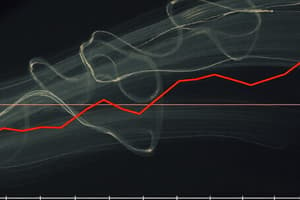Podcast
Questions and Answers
Which graph represents velocity versus time?
Which graph represents velocity versus time?
- Graph D
- Graph C
- Graph B (correct)
- Graph A
What does a negative slope on the position versus time graph indicate?
What does a negative slope on the position versus time graph indicate?
- Negative velocity (correct)
- Zero velocity
- Changing velocity
- Positive velocity
What does a constant slope on the position versus time graph indicate?
What does a constant slope on the position versus time graph indicate?
- Zero velocity (correct)
- Negative velocity
- Changing velocity
- Positive velocity
What does an abrupt change in the position versus time graph indicate?
What does an abrupt change in the position versus time graph indicate?
Which graph represents acceleration versus time?
Which graph represents acceleration versus time?
Which of the following best defines acceleration?
Which of the following best defines acceleration?
What units are used to measure speed?
What units are used to measure speed?
If an object is slowing down, what would its acceleration be?
If an object is slowing down, what would its acceleration be?
What is the acceleration of an object that is not moving?
What is the acceleration of an object that is not moving?
What happens to an object's speed when it accelerates in the direction of motion?
What happens to an object's speed when it accelerates in the direction of motion?
Flashcards are hidden until you start studying
Study Notes
Velocity and Time Graphs
- A velocity versus time graph showcases an object's speed and direction over time, illustrating the rate of change of position.
Position vs. Time Graph Analysis
- A negative slope on a position versus time graph indicates that the object is moving backwards or decreasing in position over time.
- A constant slope on a position versus time graph signifies uniform motion, meaning the object is traveling at a constant speed without acceleration.
- An abrupt change in the position versus time graph denotes a sudden shift in the object's position, indicating instant acceleration or deceleration.
Acceleration and Time Graphs
- An acceleration versus time graph illustrates how an object's acceleration changes over a period, reflecting the rate of change of velocity.
Definitions and Units
- Acceleration is best defined as the rate of change of velocity of an object over time, indicating how quickly an object speeds up or slows down.
- Speed is typically measured in units such as meters per second (m/s) or kilometers per hour (km/h).
Acceleration Insights
- If an object is slowing down, it experiences negative acceleration, often referred to as deceleration.
- An object that is not moving has an acceleration of zero, as there is no change in its velocity.
- When an object accelerates in the direction of motion, its speed increases, leading to a higher rate of motion.
Studying That Suits You
Use AI to generate personalized quizzes and flashcards to suit your learning preferences.



